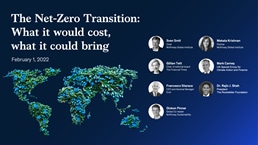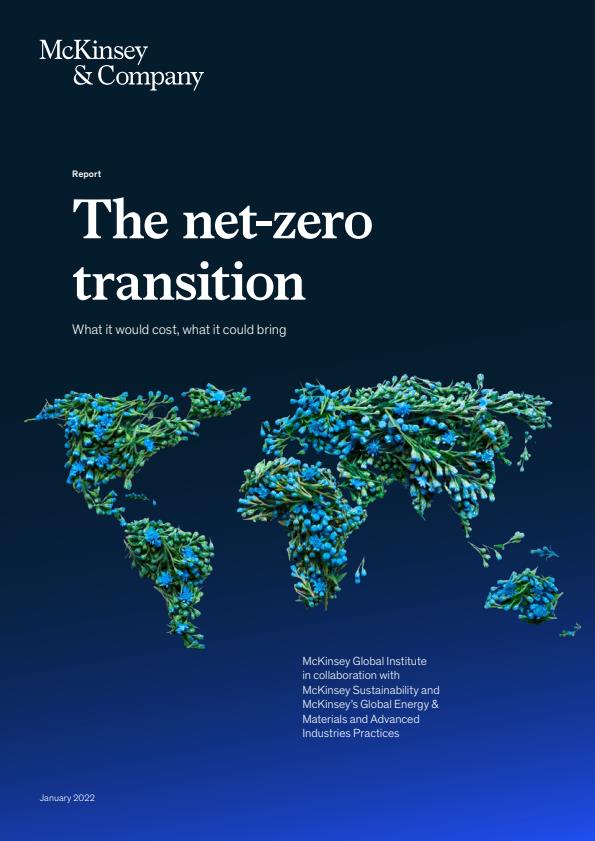The transition to net zero will require economies and societies to make significant adjustments (see sidebar, “Our research methodology: Sources, scenarios, limitations, and uncertainties”). Many of these adjustments can be best supported through coordinated action involving governments, businesses, and enabling institutions, and by extending planning and investment horizons. This action would need to be taken in a spirit of unity for two key reasons: first, the universal nature of the transition means that all stakeholders will need to play a role. Every country and sector contributes to emissions, either directly or indirectly, through its role in global production and consumption systems. Second, the burdens of the transition will not be evenly felt, and the costs will be much more difficult to bear for some stakeholders than for others. This is all the more challenging because contributions to emissions have not been even across stakeholder groups. Thus, without a real effort to address these effects in a spirit of fairness, it appears unlikely that the most affected stakeholders would be either able or willing to do their share to advance the transition.
The following three categories of action stand out:
- Catalyzing effective capital reallocation and new financing structures, including through scaling up climate finance; developing new financial instruments and markets, including voluntary carbon markets; deploying collaborations across the public and private sectors; and managing risk to stranded assets
- Managing demand shifts and near-term unit cost increases for sectors through building awareness and transparency around climate risks and opportunities, lowering technology costs with R&D, nurturing industrial ecosystems, collaborating across value chains to reduce or pass through cost increases from the transition, and sending the right demand signals and creating incentives for the transition
- Establishing compensating mechanisms to address socioeconomic impacts, through economic diversification programs, reskilling and redeployment programs for affected workers, and social support schemes
As these actions are undertaken, individual leaders will need to both consider risks and opportunities to their organizations and to their stakeholders, and determine the role they can play in supporting the necessary adjustments for all. We consider more detailed actions and the role of stakeholders below.
Companies can consider integrating climate considerations into their strategies and their decision-making frameworks. Companies have begun to develop comprehensive plans for achieving net-zero emissions and to integrate those plans into their strategies, combining elements of what might be called “offense” (such as entering new markets, funding R&D, and participating in innovation ecosystems) and “defense” (divesting businesses and retrofitting high-emissions assets to lower their emissions). As they embark on this journey, they can consider the following steps:
- Articulate and communicate a coherent case for change and upskill employees to help drive their organizations toward net-zero goals while also supporting broader economic and societal adjustments. As they initiate action, most CEOs will want to communicate a coherent case for change and take visible ownership of the sustainability agenda.
- Develop ongoing capabilities to make granular, holistic, and dynamic assessments of transition-related risks and opportunities in order to capture shifts in regulations, investor preferences, consumer behaviors, and competition. To stay abreast of new developments and emerging possibilities, organizations are likely to need new capabilities, data, infrastructure, and talent. A key part of this will also be better tracking of scope 1, 2, and 3 emissions, including through the use of digital tools to increase transparency of emissions in companies' own operations and in their supply chains.
- Define decarbonization and offsetting plans and update them as competitive, financial, and regulatory conditions change. This would include scope 1 and 2 emissions (with priority given to “no regret” actions such as improving energy efficiency and making decarbonization investment with positive returns). Where feasible, needed, and material, and depending on the nature of their operations, businesses can expand these plans to include scope 3 emissions.
- Create a portfolio of agile business strategies consistent with these decarbonization plans and with the risks and opportunities emerging in a net-zero economy. They can then put these plans in place as conditions change and opportunities arise. For companies, repositioning themselves could involve investing in new physical assets and reallocating capital, redesigning products, or building new low-emissions businesses.
- Integrate climate-related factors into key business decisions for strategy, risk management, finance and capital planning, R&D, operations (including supplier management and procurement), organizational structure and talent management, pricing, marketing, and investor and government relations.
- Consider if and where to take a leadership position in the company’s industry and its ecosystem of investors, supply chains, customers, and regulators.
Financial institutions can support large-scale capital reallocation, even as they manage their individual risks and opportunities. In the near term, they will need to consider assessing and disclosing their risks and measuring and committing to reduce their financed emissions. Over time, they will need to translate these commitments into actions that lower emissions. Relevant practices for financial institutions to consider include the following:
- Rethinking conventions for risks and returns. Some decarbonization projects are likely to have longer-than-normal payback periods. This possibility may compel financial institutions to adjust their criteria for which projects they finance.
- Assessing and disclosing climate risks. For example, various regulators and supervisors already require banks to conduct climate-risk assessments, and more are planning to start these assessments.
- Measuring and reducing financed emissions. Financial institutions are increasingly making pledges to align their portfolios with 1.5°C or 2.0°C warming targets or to achieve net-zero financed emissions by a certain date. They have started translating these commitments into targets for sectors and geographies. Given that emissions ultimately are from counterparties, financial institutions may find it helpful to support the transition plans of those counterparties—for instance, by offering new financial solutions, advising them on emissions-abatement methods, and introducing partnership opportunities.
- Over time, translating these commitments into actions that lower emissions, including expanding the range of climate-finance products and services (for example, funding for low-emissions power projects, new financial instruments to support negative emissions or nature-based solutions, and well-governed voluntary carbon markets).

Watch the replay
Governments and multilateral institutions could consider the use of existing and new policy, fiscal, and regulatory tools to establish incentives, support vulnerable stakeholders, and foster collective action. Public-sector organizations have a unique role in managing uneven effects on sectors and communities. Among other options, they could consider the following:
- Assess exposure to risks and opportunities, develop decarbonization plans, and create net-zero strategies (similar to businesses). This would include governments bringing climate considerations into decisions about such matters as urban planning, infrastructure development, and tax and subsidy regimes in an effort to anticipate future dynamics, as well as efforts to increase awareness of and transparency about climate risks and opportunities. One major adjustment that governments may need to make is developing new low-emissions industries as demand wanes for fossil fuels and emissions-intensive industries.
- Use policy measures and regulation to encourage decarbonization investment across sectors (for example, consider where and how to best use subsidies, grants, demand signals, and carbon taxes, to name a few). They can also play a role in accelerating research and development that would lower technology costs.
- Governments could establish multilateral and government funds to support low-carbon investment and manage stranded-asset risk.
- Institute reskilling, redeployment, and social-support programs for workers and manage negative effects on lower-income consumers.
- Collaborate with other stakeholders to drive collective action. For example, governments can catalyze private-sector action to build new low-emissions industries in various ways; strategies might include setting road maps and convening stakeholders.
Enabling institutions such as standard setters, industry groups, and civil-society coalitions will be critical in coordinating action across sectors and geographies. Although individual actions by companies and governments can support a wide range of stakeholders during the transition, these actions may not be enough to meet all stakeholder needs. The pace and scale of the transition means that many of today’s institutions may need to be revamped and new institutions created to disseminate knowledge, support capital deployment, manage uneven effects, and organize collective action. Enabling institutions could play valuable roles in developing and enforcing governing standards, tracking, and market mechanisms (for example, related to the measurement of emissions or climate finance), convening stakeholders and facilitating collaboration (for example, to arrange collective investment or organize the build-out of infrastructure), and giving a voice to vulnerable workers and communities.
Individuals will need to manage their own exposure to the transition and can play powerful roles as consumers and citizens. They can begin by continuing to learn about the effects of both ongoing climate change and the net-zero transition that they may experience as consumers or workers. The goal of net-zero emissions can be reached only if people adopt new behaviors and consumption patterns, such as switching to electric vehicles and renovating or retrofitting homes for energy efficiency. Civic discourse has an important role to play: an informed, engaged public that recognizes the imperative for a net-zero transition could spur decisive and transformative action on the part of government and business leaders.
The economic transformation required to achieve net-zero emissions by 2050 will be massive in scale and complex in execution. The transition would bring substantial shifts in demand, capital allocation, costs, and jobs, which will be challenging to a wide range of stakeholders, not least because they will be distributed unevenly. Yet the costs and dislocations that would result from a more disorderly transition to net-zero emissions would likely be far greater, and the transition would prevent the further buildup of physical risks. The findings of this research serve as a clear call for more thoughtful and decisive action, taken with the utmost urgency, to secure a more orderly transition to net-zero by 2050. It is important not to view the transition as only onerous; the required economic transformation will not only create immediate economic opportunities but also open up the prospect of a fundamentally transformed global economy with lower energy costs and numerous other benefits—for example, improved health outcomes and enhanced conservation of natural capital. Actions by individual companies and governments, along with coordinated action to support more vulnerable sectors, geographies, and communities, could help support the needed economic and societal adjustments. The key issue is whether the world can muster the requisite boldness and resolve to broaden its response during the upcoming decade, which will, in all likelihood, decide the nature of the transition.



